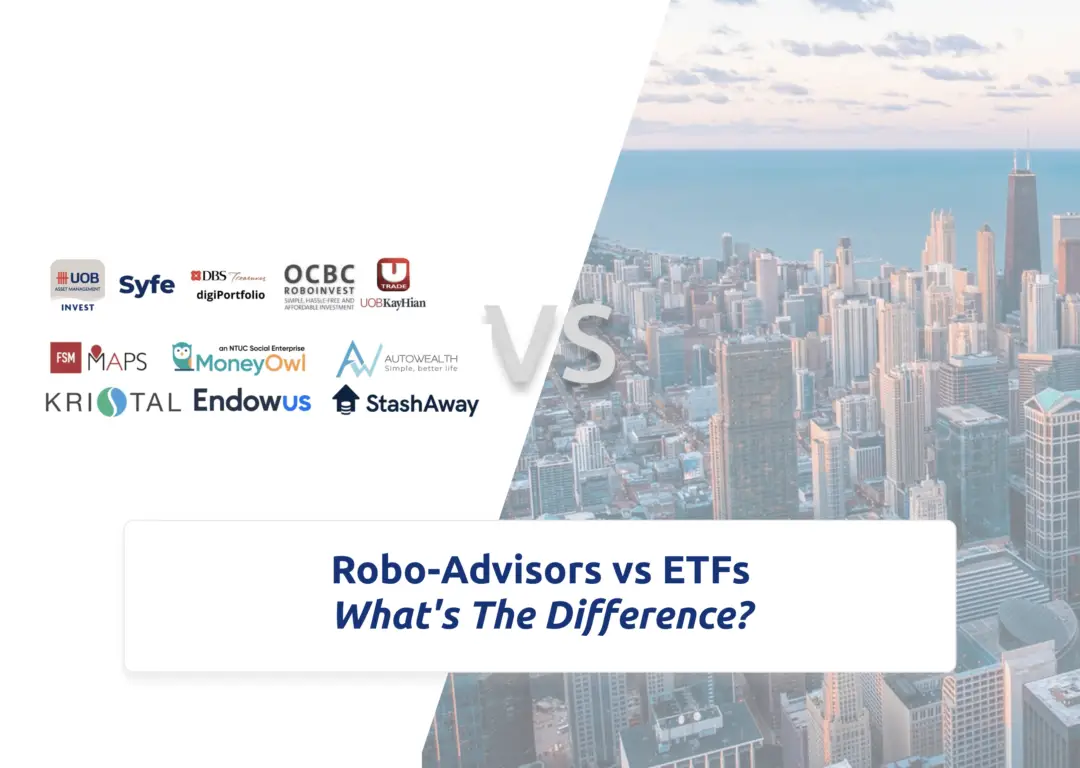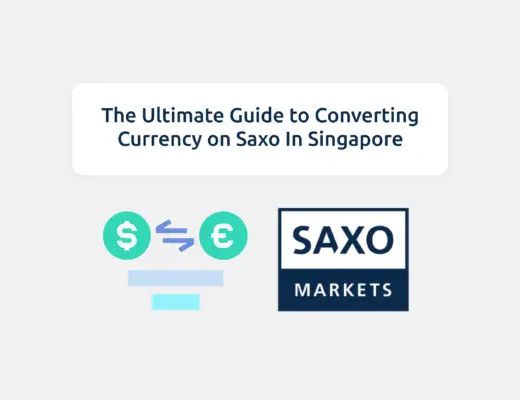When it comes to investments, there are a ton of different products to choose from. This may be overwhelming if you are new to investing, especially if you’re a student.
The good thing is that some of them, such as robo-advisors and ETFs, help to take out quite a lot of stress from investing.
Here’s what you need to know regarding these 2 investment options.
Contents
The Difference Between Robo-advisors and ETFs
Exchange Traded Funds (ETFs) buy into a basket of stocks or bonds, while robo-advisors use different ETFs or mutual funds to build a portfolio which caters to your risk profile. You can choose your investing strategy when you buy an ETF, but you are relying on the investing strategy of the robo-advisor if you invest with them.
Let’s understand what these 2 investment options actually are first!
Exchange Traded Funds (ETFs)
Exchange-Traded Funds – or more commonly known as ETFs – are baskets of pre-selected securities such as stocks and bonds.
Take the popular S&P500 as an example. The S&P500 ETF features an array of some of the biggest companies such as:
- Apple
- Microsoft
When you buy into the S&P500 ETF, you own a tiny portion of each stock that is found in the index. This means that if the stock price of Apple starts to drop, you have other companies such as Microsoft that can help to alleviate the dip.
As such, ETFs have gained popularity among both advanced and beginner investors looking to diversify their portfolios. You can buy one ETF and own a large number of stocks with just this fund.
This saves a lot on the time and effort managing and allocating your investments!
Robo-advisors
Robo-advisors are digital platforms that provide automated financial solutions. They are equipped with algorithms to understand your financial needs, and then allocate a portfolio that is most suitable for your goal.
Since such apps and platforms leverage technology to deliver high quality investment advice, this allows them to scale up more efficiently.
Though there are various types of robo-advisors, the basis behind them is more or less the same.
- You create an account on your chosen platform.
- You will share the goal you are saving up for, as well as your risk tolerance.
- A suitable portfolio will be recommended to you by the platform.
- After transferring the funds to your account, the platform will invest into the funds that make up your portfolio
The portfolio that the robo-advisor chooses for you will contain a variety of stocks and bonds, that are based on their investing strategy.
For example, Endowus invests your funds into the various portfolios, depending on your risk level:
| Portfolio | Equities | Fixed Income |
|---|---|---|
| Very Aggressive | 100% | 0% |
| Aggressive | 80% | 20% |
| Balanced | 60% | 40% |
| Measured | 40% | 60% |
| Conservative | 20% | 80% |
| Very Conservative | 0% | 100% |
The higher your risk tolerance, the greater the allocation towards equities and vice versa.
Within the equity and fixed income portions, they actually invest in a variety of funds. Endowus will invest your money into equity funds which include:
- LionGlobal Infinity U.S 500 Stock Index Fund
- Dimensional Global Core Equity Fund
By purchasing a variety of funds within the equity sector, you are diversifying your investments even more! This is because some sectors within the equity sector may perform better than the others.
As such, robo-advisors are simple investment instruments that are very automated. They are meant to let you invest passively in the long run, so don’t expect to make short-term gains!
Investment Strategy
The first differentiator to note about ETFs and robo-advisors is that ETFs allow you to pick an investment strategy, while robo-advisors do not.
ETFs allow you to choose your investment strategy
With ETFs, you have the freedom and flexibility to choose the investment strategy that best suits you. Each ETF will have its own investment strategy and will contain a different allocation of stocks and bonds.
Some ETFs may focus on tech companies, while others comprise companies in the clean energy industry.
Besides being allocated by industry, ETFs can also be categorised based on how big or small the companies are. With a wide selection to choose from, you will have the opportunity to pick an array of ETFs that are aligned with your investment strategy.
This enables you to have the flexibility to combine high and low risk ETFs for a more diversified portfolio.
There are many types of investment strategies to choose from and here are some common ones.
- Growth Investing
- You decide on the products and timeframe based on the growth you intend to have in your portfolio.
- For long-term growth, you would buy into companies you believe have the potential for growth in the long run.
- For short-term growth, you would choose companies that deliver significant value in a shorter time span.
- Value Investing
- The value investing strategy involves buying into companies that are known to be undervalued by the stock market.
- The idea behind investing in such companies is that when the market enters correction, it will correct the value for such undervalued companies. The price will then increase, allowing you to earn higher returns when you sell it off.
- Low-Risk Investing Strategy
- Low-risk investments include buying into investment products that are known to be safer.
- Diversification is another aspect of low-risk investing. This means spreading out your investment holdings across several investment types. Diversifying your portfolio in this way can help safeguard against losing all of your funds in the event one investment does not perform well.
Here, let’s break down the common investment strategies and the type of ETFs you may want to consider purchasing.
| Investment Strategy | Type of ETFs |
|---|---|
| Growth Investing | 1. Invesco Dynamic Semiconductors ETF (PSI) 2. First Trust Small Cap Growth AlphaDEX Fund (FYC) |
| Value Investing | 1. Vanguard Value ETF (VTV) 2. iShares Russell Mid- Cap Value ETF (IWS) |
| Low-Risk Investing | 1. SPDR S&P 500 ETF (SPY) 2. Vanguard Total Stock Market Index Fund ETF (VTI) |
You rely on the investment strategy of robo-advisors
You are able to choose the type of portfolio you want to buy on the robo-advisor platform based on you risk profile and time horizon for a particular financial goal. However, most of the time, you can’t pick an investment strategy to pursue.
This is so as with robo-advisors, professional teams and advanced technologies are working on optimal investment strategies for you to earn consistent returns.
As such, robo-advisors are great for beginners and those who do not wish to actively manage their portfolios.
Most of the groundwork is done by the technology employed. All you would need to do is choose the type of portfolio to invest in.
However, it is also important to note that each robo-advisor has their own strategy, so each platform actually chooses different ETFs or mutual funds.
Thus, robo-advisors do allow you to diversify into a variety of ETFs or mutual funds to a certain extent. So if you want to own more than 1 ETF, then a robo-advisor may be more efficient in helping you manage this.
There are robo-advisors that do offer some flexibility too! Endowus has its fund smart, while Syfe has its select custom portfolio. These actually allow you to choose which funds or ETFs you can use in your portfolio.
However, if you prefer choosing and managing your own investment strategy, ETFs might be a better option.
But of course, having a portion of your assets in robo-advisors doesn’t really hurt since it’s a prime way to earn passively.
There are numerous robo-advisors to choose from and each has their own niche.
| Robo-Advisor | Portfolios Offered |
|---|---|
| Syfe | 1. REIT+ 2. Equity100Core |
| Endowus | 1. Cash Smart 2. Fund Smart |
| Stashaway | 1. General Investing 2. Goals-Based Investing 3. Income Portfolio |
Minimum Sum
Here are the minimum sums for these 2 investment options:
The minimum sums for ETFs depend on the number of units
For the SGX and NYSE, the minimum number of units for each ETF is 1.
Therefore, the minimum sum for each ETF depends on the unit price of the ETF at the current listing.
For example, one unit of the Vanguard 500 Index Fund ETF (VOO) is currently priced at approximately US$399. On the other hand, each unit of the iShares Core MSCI World UCITS ETF (IWDA) is priced at approximately US$81.
You’ll notice that the minimum sum differs for each ETF and is dependent on the unit price.
Robo-advisors may have lower minimum investment requirements
Unlike ETFs, robo-advisors may have lower minimum sum requirements. This is so since a handful of robo-advisors offer more flexibility when you invest in them.
To get a better understanding, here’s a break down of the minimum sum required by some of the more popular robo-advisors. You’ll notice that a number of them don’t even require an initial minimum investment amount!
This means that you’ll have the flexibility and control over the amount you wish to invest in.
| Robo-Advisor | Minimum Investment Sum Required (SGD) |
|---|---|
| Syfe | $0 |
| Endowus | $1,000 |
| Stashaway | $0 |
| MoneyOwl | $100 initial lump sum OR $50/month |
| Kristal.AI | $100 |
| OCBC RoboInvest | $3,500 |
| DBS DigiPortfolio | $1,000 |
While some robo-advisors do require you to deposit a minimum amount into your account, there are others such as Syfe and Stashaway that require no monetary commitment upfront.
This is great for beginners who are looking to try out an investment platform!
All in all, it really boils down to you and the amount you’re willing to set aside for your investments! Though both ETFs and robo-advisors offer options that come with no minimum investment requirements, it is important to do thorough research before buying into them.
Fees and costs
Besides investment strategies and minimum investment requirements, one aspect that differentiates robo-advisors and ETFs is the associated fees.
ETFs have a number of additional costs to consider
When it comes to investing in ETFs, you might want to note that it would incur additional costs.
Moreover, the fees and costs may significantly eat into your profits. As such, it is important that you are aware of these costs. Here, let’s discuss some you’ll need to know:
#1 Management Fees (aka expense ratio)
Management fees are mandatory when investing in an ETF. This is so since you would need to pay for the service of the management who is managing the ETFs.
Let’s take the Nikko AM STI ETF as an example. If you bought the Nikko AM STI ETF, you would be required to pay an annual management fee of 0.20% per annum.
This means that you would be required to pay 0.20% of management fees every year based on the Net Asset Value (NAV) of the ETF, and not the amount you invested in! The NAV of an ETF refers to the value of each share’s portion of the fund’s underlying assets minus the total liabilities.
For example, if an investment company has securities and other assets worth $100 million and has liabilities of $10 million, the investment company’s NAV will be $90 million.
As such, the NAV of ETFs would differ each year. This means that the 0.20% of management fees paid every year will vary based on the NAV of the ETF at that given point in time.
This is also commonly referred to as the ETF’s expense ratio.
Commission Fees
Moreover, you will also have to pay a commission fee to the brokerage platform when you purchase ETFs. This is similar to the fee you would need to pay when you buy and sell stocks through an online brokerage platform, such as Tiger Brokers or moomoo.
You save on transaction costs with robo-advisors
Robo-advisors are known to charge low annual management fees. However, these fees will have a compounding effect, which may eat into your returns.
Therefore, it is important to decide whether the value that the robo-advisor provides is worth the fees you pay.
You are paying two layers of management fees:
- One for the ETFs themselves
- One for the robo-advisors
More importantly, robo-advisor fees are recurring costs and there is also a currency conversion fee you need to take note of.
If you like the benefits of having ETFs in your portfolio and prefer a more flexible, DIY approach to your investments, then ETFs may be ideal.
Essentially, you would need to evaluate if you want something more passive like robo-advisors, or if you’d rather review and manage your portfolio on your own!
So… ETFs or robo-advisors?
While it might sound cliche, the choice is really up to you!
Here’s a summary of what has been discussed when comparing ETFs and robo-advisors.
| ETF | Robo-Advisor | |
|---|---|---|
| Main Feature | Basket of pre-selected stocks | Digital platforms that provide automated financial solutions |
| Investment Strategy | More freedom to choose your own investment strategy | Less flexibility |
| Minimum Sum | Depending on the ETF and the market they are listed on | Lower minimum sum requirements |
| Fees | Fees differ based on the ETF you choose. Some fees to note: 1. Management Fees (Expense Ratio) 2. Commission Fees | Lower annual management fees |
If you’re a total newbie and need some help with investing, robo-advisors do seem enticing since you don’t have to actively manage your portfolios.
However, if you already have some knowledge, ETFs might be a better option since you’re able to craft an investment strategy that suits you.
Bear in mind that both products do come with additional fees that you need to be aware of.
Thus, it is important to thoroughly research the platform you’re using and the products you’re looking to purchase.
If you want a variety, buying into both is a good option too! You’ll get the flexibility of managing your own portfolio with ETFs and the fuss-free experience of robo-advisors.

Do you like the content on this blog?
To receive the latest updates, you can follow us on our Telegram channels (Personal Finance or Crypto) and Facebook.
Are you passionate about personal finance and want to earn some flexible income?





